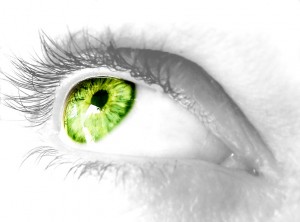In our last blog about the definition of Drishti,we talked about using this “gaze” as an anatomical tool to self-correct your posture while practicing yoga. But we also highlighted it as a useful implement to quiet the mind and increase relaxation while avoiding obsessive thoughts. But the benefits of this aspect of yoga can go beyond simply a place to look during Downward Dog.
Another important subtlety in the concept of Drishti is in the different ways of gazing. This is a vari ation on the practice of detachment but specifically, a Drishti can be described as ´soft´, ´pointed´, ´wide´, ´gentle´, etc. Again, there are very practical reasons for this. Even though Patanjali never gazed at a computer screen, he could imagine what hours of single distance, harsh gazing can do to your eyes. Varied distances of Drishti, as well as varying degrees of hardness or staring in the postures, helps to exercise the optical nerves and reduce the strain that can produce tension headaches.
ation on the practice of detachment but specifically, a Drishti can be described as ´soft´, ´pointed´, ´wide´, ´gentle´, etc. Again, there are very practical reasons for this. Even though Patanjali never gazed at a computer screen, he could imagine what hours of single distance, harsh gazing can do to your eyes. Varied distances of Drishti, as well as varying degrees of hardness or staring in the postures, helps to exercise the optical nerves and reduce the strain that can produce tension headaches.
Early yogis and yoginis realized that the quality with which you observe something radiates through your body. Your body naturally becomes more tense and rigid, or soft and relaxed, depending on how you are looking at something. A soft Dristhi promotes internal reflection, relaxation, meditation. A harder one pushes the focus externally. Both can be useful, but the eyes should never strain.
So, the next time you find your eyes wandering, watch your mind and body, and see if you can notice how your Dristhi affects you. And next time you practice yoga, play with your gaze point and see how it affects your practice and your life.
For more information about our new schedule for Yoga in Kreuzberg check out our English Yoga classes.







